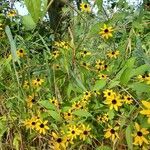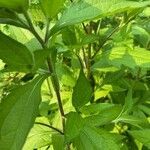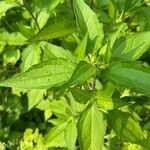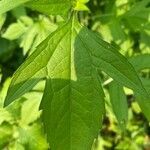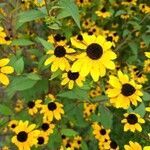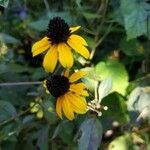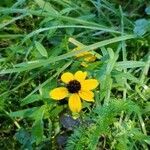Perennials, to 150 cm (rhizomatous). Stems glabrate to hirsute or strigose (hairs 1–2 mm, basal retrorse, others spreading). Leaves: blades ovate to subcordate or elliptic (not lobed), margins serrate, apices acute to acuminate, faces hirsute to strigose; basal petiolate, 10–30 × 2–8 cm, bases truncate or rounded to cordate; cauline petiolate or sessile, ovate to elliptic, proximal usually 3–5-lobed, 2–20 × 1.5–8 cm (smaller, fewer lobed distally), bases rounded to attenuate, sometimes clasping. Heads (10–30) in paniculiform arrays. Phyllaries to 1.5 cm (faces moderately hirsute). Receptacles conic to subhemispheric; paleae 5–6.5 mm, apices cuspidate (tips awnlike, 1.5+ mm), glabrous. Ray florets 8–15; laminae (corollas yellow to yellow-orange with basal maroon splotches) linear to oblanceolate, 8–30 × 3–8 mm, abaxially sparsely strigose. Discs 8–15 × 10–20 mm. Disc florets 150–300+; corollas yellowish green basally, otherwise brown-purple, 3–4 mm; style branches ca. 1.2 mm, apices obtuse to rounded. Cypselae 1.9–2.8 mm; pappi coroniform, to 0.2 mm.
